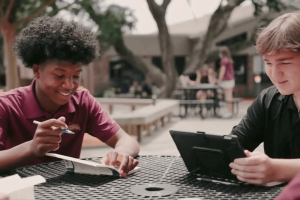There is a growing IT challenge in K12 education… As K12 schools have embraced digital transformation—implementing cloud-based EdTech tools, virtual classrooms, and administrative platforms at an accelerating pace, they have also learned the hard lesson that with greater digital reliance comes increased exposure to cyberthreats.
From ransomware and phishing to zero-day exploits, school districts are now high-value targets to cybercriminals due to the sensitive data they protect, including student records, health information, and staff payroll data. A single vulnerability can lead to class disruptions, financial losses, legal penalties, and lasting reputational harm (not to mention the compromise of sensitive information).
Did you know that 57% of breaches in the education sector are caused by known vulnerabilities with patches that are available but not applied (Cost of a Data Breach Report)? By implementing an optimized and automated Patch Management as a Service (PMaaS) solution, school districts can reduce the probability of a successful cyberattack by up to 60%, simply by eliminating these known, preventable exposures. Unfortunately, many K12 IT teams operate with limited resources, outdated systems, and minimal staffing—making it difficult to maintain the continuous patching and vigilance required to stay secure. This is where PMaaS can help.
PMaaS: A Foundational Element of Cyber Resilience for K12 Schools
Patch Management as a Service (PMaaS) is a critical component of a mature vulnerability management program. It ensures operating systems and applications are updated with the latest security patches, minimizing the window of exposure to known cybersecurity threats. By automating the patching process, PMaaS delivers consistent, proactive protection without adding to internal IT workload, helping schools stay secure, compliant, and operational while avoiding cyber incidents.
Preventing Cyberattacks with Timely Patching
Unpatched systems continue to be one of the most exploited entry points in school environments. Lean IT teams often struggle to keep pace with security updates, giving attackers a window to compromise systems with malware, phishing attacks, etc. PMaaS can help K12 schools automate patch deployment across devices and servers, address zero-day and critical vulnerabilities quickly, and reduce human error and delays in applying fixes.
Enabling Compliance with Regulatory Mandates
Schools are subject to federal and state-level cybersecurity regulations, including Family Educational Rights and Privacy Act (FERPA), the Children’s Internet Protection Act (CIPA), and the Children’s Online Privacy Protection Rule (COPPA). Thanks to the expert support and services provided by IT solutions like PMaaS, K12 schools can maintain patch compliance with regulatory frameworks, provide reporting for audits and funding eligibility, and ultimately reduce noncompliance risk, fines, and data breach liability.
Protecting Learning Continuity & Minimizing Downtime
Cyberattacks can halt instruction, block access to digital learning tools, and lock staff out of critical systems. In remote or hybrid settings, even brief outages can disrupt student progress. A 2022 ransomware attack on a Florida school district (caused by—you guessed it—an unpatched vulnerability) managed to disrupt learning and operations for weeks. PMaaS could have prevented the incident by closing that known vulnerability in advance. PMaaS providers can schedule updates during off-peak hours to avoid interrupting operations, prevent downtime by closing exploitable gaps, and work with Remote Monitoring and Management (RMM) tools for proactive detection
Why Outsource Patch Management?
When K12 organizations choose to outsource PMaaS to an expert provider they gain greater operational and financial efficiency compared to managing these IT tasks in-house:
- Internal teams save time by automating routine, labor-intensive patching tasks,
- Districts avoid the overhead of hiring additional staff or purchasing standalone tools, and
- Access to expert-level patch management improves consistency and audit readiness.
Combined, these efficiencies help school systems stretch limited budgets while improving their overall security posture.
Complementary K12 Cybersecurity Services
PMaaS is most effective when it is implemented as part of a layered cybersecurity approach for educational institutions. While not required, Managed IT Services providers like UDT typically recommend additional services (like those listed below) with PMaaS to provide the best support and service to address the needs of K12 customers.
Managed Detection & Response (MDR/XDR)
- 24/7 threat monitoring and incident response
- Works alongside PMaaS to contain advanced threats
Help Desk & Co-IT Support
- Strategic and technical assistance for understaffed IT departments
- Supports patching, compliance, and incident response
Remote Monitoring & Management (RMM)
- Continuous oversight of device health and update status
- Enhances patch automation and threat alerting
Best Practices for a Successful PMaaS Implementation
To maximize impact, there are a few best practices that K12 schools should adopt to drive a successful implementation of their PMaaS solution. PMaaS is great for reducing risk, but training staff and students on cybersecurity hygiene can make security efforts more effective overall. Other digital protections, like enforcing a Multi-Factor Authentication (MFA) policy, utilizing network segmentation to limit breach spread, and deploying an Endpoint Detection & Response (EDR) tool can also bolster security. Partnering with an experienced cybersecurity provider like UDT can make managing your security strategy, tools, and protocols more seamless and ensure that nothing critical is missed.
A Strategic Investment in Cyber-Ready Education
Cybersecurity is no longer optional—it’s a prerequisite for safe, uninterrupted learning. An expertly managed PMaaS solution can help K12 achieve an optimized security posture so teaching and learning experiences remain seamless. With PMaaS, school districts can expect outcomes like:
- Staying secure without stretching IT teams thin,
- Reducing risk exposure from unpatched systems,
- Meeting compliance and funding requirements, and
- Maintaining classroom continuity amid evolving threats.
Patch Management as a Service helps lay the foundation for a comprehensive cybersecurity strategy. It’s not a silver bullet—but it’s an essential step toward reducing cybersecurity risk.
Ready to enhance your school’s cybersecurity?
UDT’s cybersecurity solutions—including PMaaS, RMM, and MDR—can help you build a cybersecurity roadmap to help protect student and staff data privacy while safeguarding your digital learning environment. Contact UDT today to learn how we can help your school district with device lifecycle management, break-fix, cybersecurity, and risk management.
FAQs
- What is Patch Management as a Service (PMaaS)?
PMaaS is a managed service where updates and security patches for software, devices, and operating systems are automatically deployed by a trusted provider to protect against vulnerabilities. - Why are K12 schools frequent targets of cyberattacks?
K12 schools often lack robust cybersecurity resources and house valuable student data, making them ideal targets for hackers, especially ransomware groups. - How does PMaaS differ from regular patch management?
Unlike manual or in-house patching, PMaaS is fully managed, automated, and integrated with broader cybersecurity services, reducing risks and saving time. - Can PMaaS help during a ransomware outbreak?
Yes. While it’s primarily preventative, PMaaS also limits the attack surface and can reduce the severity of an attack if it occurs, speeding up recovery. - Is PMaaS affordable for budget-constrained districts?
Yes. PMaaS is typically offered as a scalable subscription service, allowing districts to choose plans that align with their size, needs, and budget.











